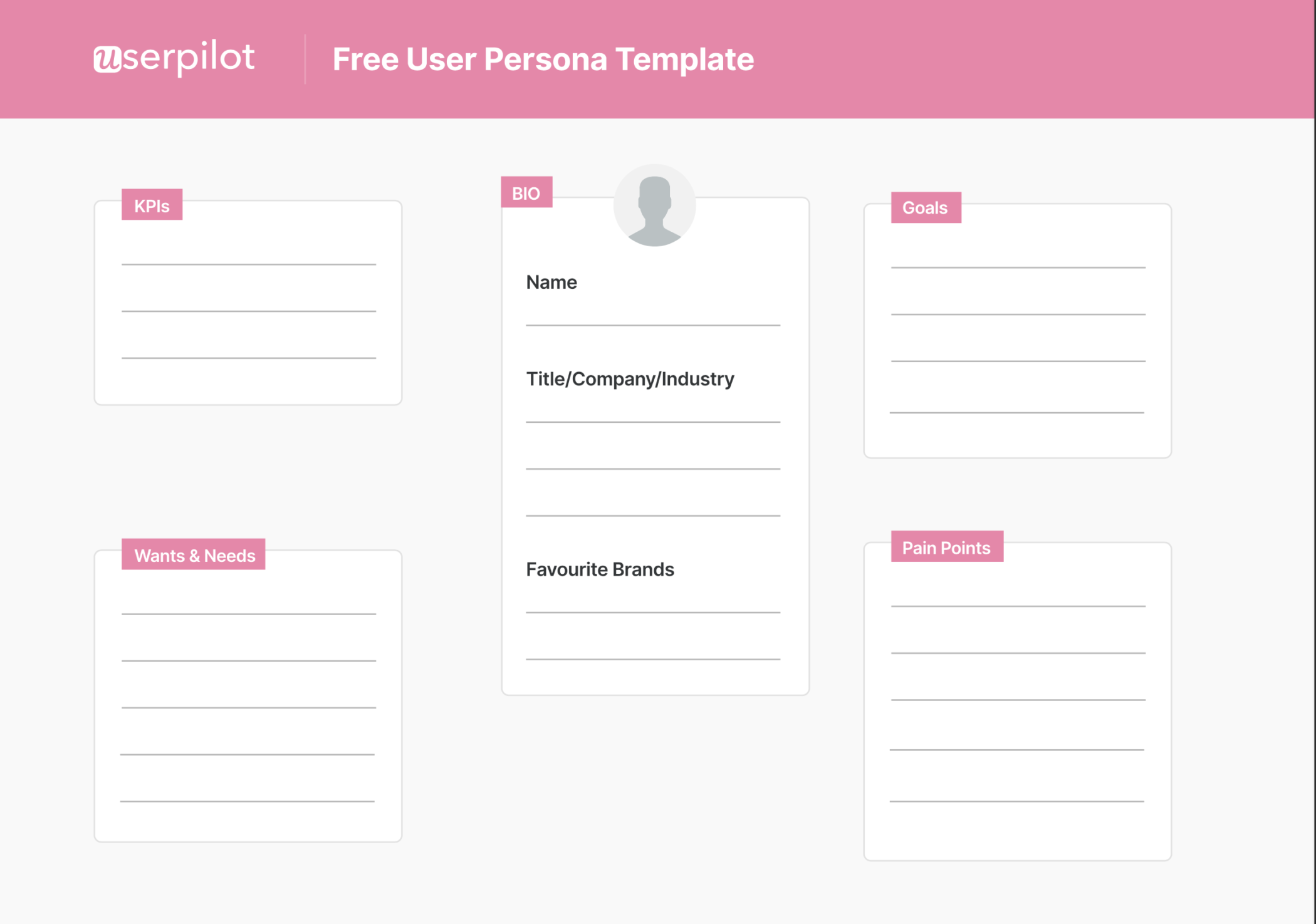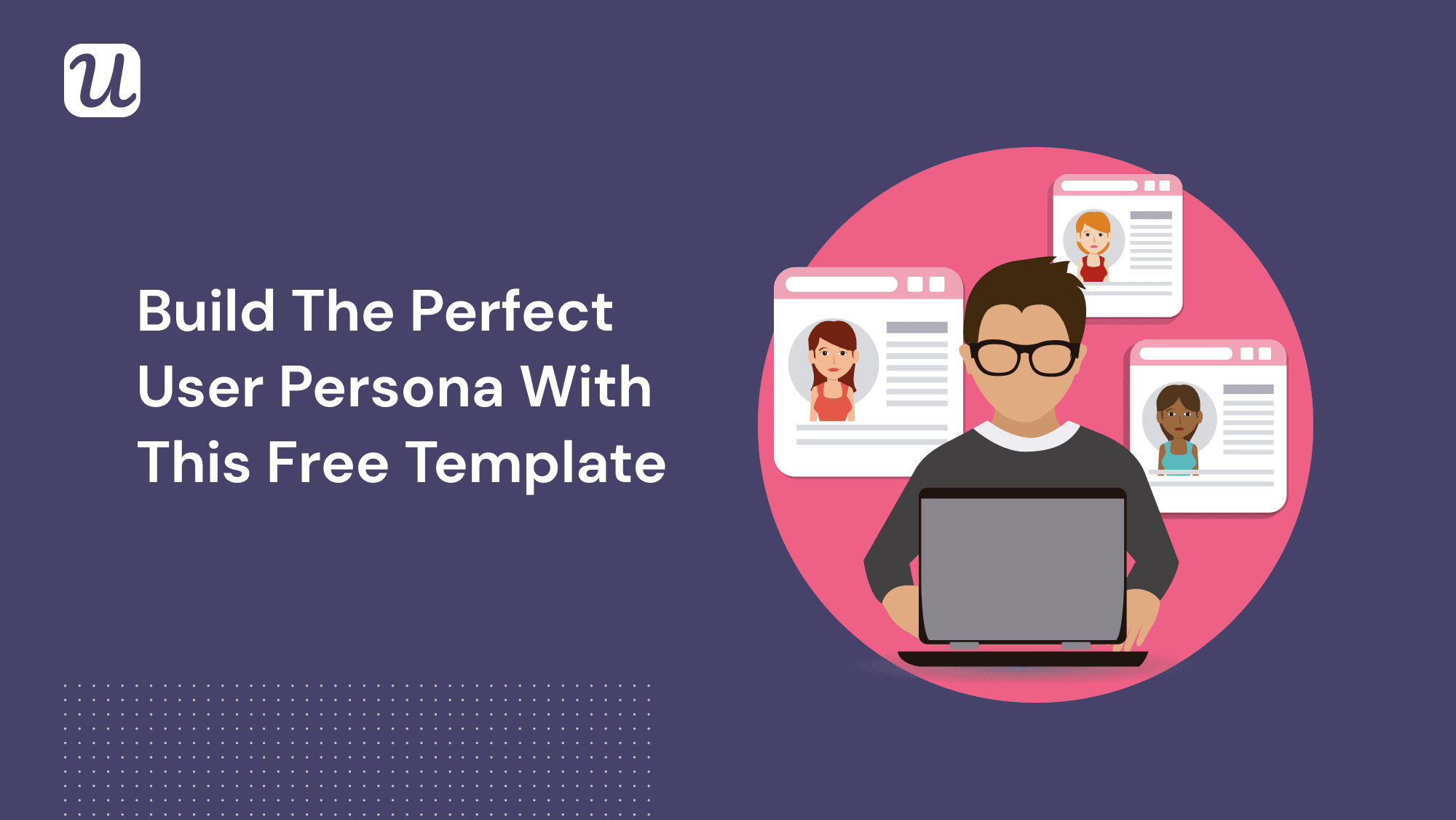
Free User Persona Template for SaaS – The Fastest Way to Create a User Persona for Your SaaS Business
User persona templates are a shortcut to creating a user persona from scratch for your SaaS business. If you need a template RIGHT now, take a deep breath – you have come to the right place. Contrary to conventional wisdom, for B2B SaaS, you don’t need to fill in every little detail about your user like their favorite food or where they went to school to create a user persona – it’s not a dating profile.
You can get an accurate picture of your ideal user just by asking three questions:
- Who are they?
- What is their primary goal?
- What is their main pain point in achieving this goal?
These questions have a lot to do with Tony Ulwick’s Jobs-To-Be-Done-Framework.
In a nutshell: You are building a product that your users need to do a specific job.
You want your product to fit that job as much as possible so that they continue to “hire” your product as the solution to get the job done.
So who needs this job to be done the most?
Once you figure that out, you can read through our article, where we will cover what is a user persona, why your SaaS absolutely needs one, examples of user personas, and when to use them.
Finally, some tips for segmenting and collecting the data you need + the free user persona template!
Try Userpilot Now
See Why 1,000+ Teams Choose Userpilot

Summary of user persona template for SaaS
- A user persona is a semi-fictional character that is created based on who you believe will most likely get the most value from your product.
- A buyer persona is a decision-maker, while the user persona is the person actually using your product.
- If you are developing a product without a specific persona in mind, your company won’t become profitable.
- User personas are based on specific segments of your user base. The segment you should prioritize should represent 20% of your user base and account for 80% of your revenue.
- You can quickly collect the data for your ideal user persona by segmenting your user base in your product analytics tool and launching an in-app survey tailored to find out the most relevant information.
What Is a User Persona?
A user persona is a character that you create based on who you think will benefit the most from your product and who will get the most value out of it.
Getting your user persona right is particularly important because of that. The better you define the person who will be your product’s biggest fan, the lower the chance you will be barking up the wrong tree. And the fewer problems and lower churn you will have in the future.
User personas are made by collecting data through user interviews -this is where you find out how they think, and then segmenting based on their demographic data -you can find this in your product analytics tool.
User persona templates are developed for two scenarios. Depending on your goal, the focus on your template will be slightly different:
- A particular product/project. The persona is much more focused on goals and pain points collected during user journey mapping exercises, in-app surveys, and interviews (which is what we will be focusing on in this article).
- To consistently build your developer’s empathy for your users over time and across multiple products/features. These are long-standing personas that anyone in the company can continuously look at for reference. They are based on months of research.
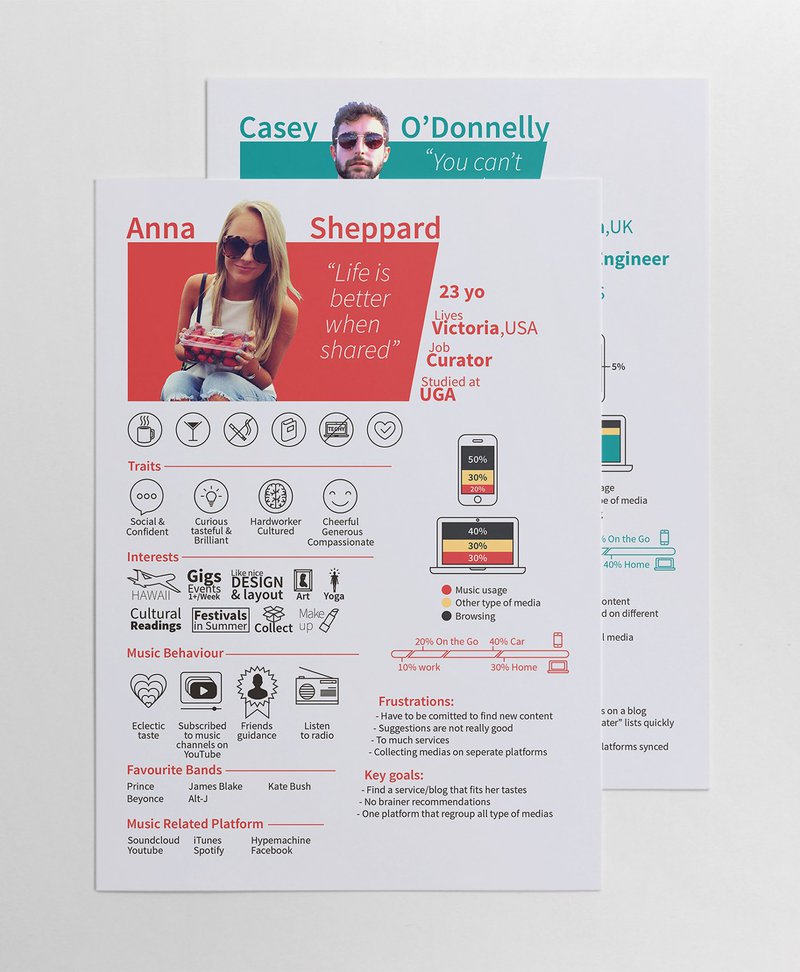
Source: Behance.com
Now, the templates above look amazing and work great for a B2C music app. However, for a B2B SaaS company, this is way too much information for either of the two scenarios in creating a user persona template.
You have to be careful with who you are researching as well. There are some fundamental differences between the user persona and the more common buyer persona.
What Is the Difference Between a Buyer Persona and a User Persona?
SaaS products should keep an eye out that the decision-maker (the buyer) can be different from the product user (active user).
A Chief People Officer will buy HR software because they are concerned with optimizing their recruiting process. The recruiters are actually the ones who will be using it. They will be organizing the candidates in their pipeline and through the interview stages. They will be the ones passing on their comments and frustrations to the CPO, which may influence his/her next buying decision.
Why Is It Important to Build a User Persona for SaaS
If you develop a product that misses the expectations of the persona you’re building it for – let’s face it – it’s going to flop.
But most SaaS companies seem to be getting their personas wrong. Rather than focusing on the particular group of users’ pain points and problems, and how these problems make them feel, and how seriously they affect their lives – they focus on superficial aspects.
They will give their user personas cute names (Nerdy Nancy, Manager Mike) and personality traits (Likes to slam a couple cold ones on the weekend) that have nothing to do with how they are going to use your product – and most importantly – why.
With the right user persona, you will tap into a specific pain point and see your conversion rates skyrocket. The more users that experience the value in your product, the more possibilities you have to grow your ARR and reduce your churn.
What Does a User Persona Look Like?
One important consideration when deciding what your user persona will look like for a specific product/project is Pareto’s Principle. The 80 by 20 concept can be used for a variety of business cases but for product marketing, it means that your ideal user will represent 20% of your user base, use 80% of your features, and account for 80% of your revenue.
These are the users who understand your product and are willing to open their wallets to use it. The more you study the users that fit into this category, the closer you will be to attracting more of them.
Why?
You can use the insights from their behavior and demographics to design product experiences that appeal to everyone that fits the persona.
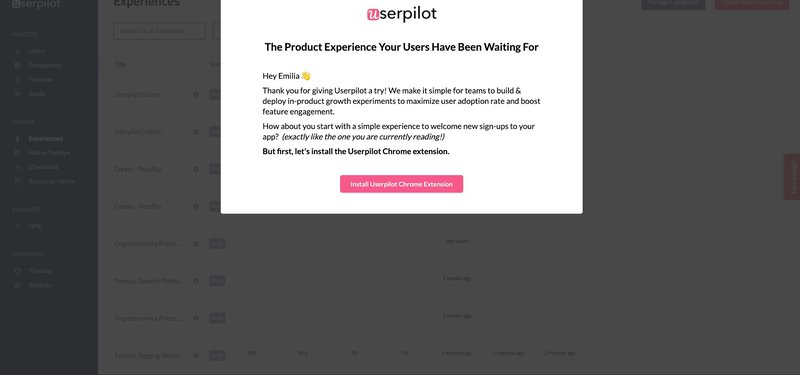
Source: userpilot.com
So Pareto’s principle represents your ideal segment-the ones who will drive your revenue. But you shouldn’t stop there. Let’s see how many user personas you actually need.
How Many Personas Do You Need?
Although one user persona is sufficient for specific insights, do not try to use it to summarize your entire audience.
There will be significant variations in your user base. Each user persona will help you understand which segments to prioritize and which don’t have any value.
You will want to have only one or two personas that your team can continually reference for long-lasting projects. Each specific element from your road map that you take on might focus on a particular user type.
For example, a software developer persona might account for only 2% of your user base but is a critical persona for a project focused on API integrations.
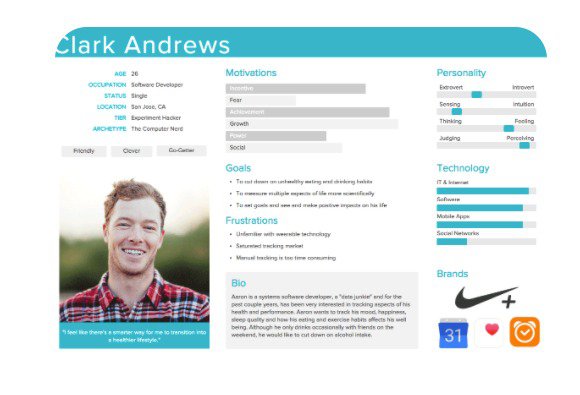
Source: UXplanet.org
Now that we understand user personas’ core elements, let’s try and save you some time in collecting the data to build your own.
How to Collect the Data in Record Time for Your User Persona
If you find yourself strapped for time and only have a couple of hours to update your user personas, you won’t be able to conduct a complete analysis.
However, you can still get a pretty good understanding of your user persona through these quick steps and use the data you collect to build your template.
Step 1: Segment your existing user base according to desired user activity
If you already have some users -great, your job will be a lot easier. If you don’t-still ok, you can use this exercise to think about what the ideal user’s behavior would be.
The best way to understand who your ideal user is – is to look at your most successful and happy user segment, and then drill down to who they are. (Remember Pareto’s principle!)
This is actually a better way to create your user persona – because it’s much more objective to look at what people are actually doing, rather than asking them what they are doing, and what their motivation is.
In the words of Erika Hall, (author of Just Enough Research): “When the research focuses on what people actually do (watch cat videos) rather than what they wish they did (produce cinema-quality home movies) it actually expands possibilities.”
If you just select a random group of users or people for interviews it’s very hard to get answers that don’t contain any bias. People like to project their ideal identity (especially onto strangers!) to ‘look good’, and help other people.
They may subconsciously tell you what you want to hear or what they would like to do, rather than what they really do. You need real answers from the people that understand your product.
How to find your most happy/successful users or the so-called ‘power users’?
You want to take a look at your product analytics tool and segment your users according to:
- Who has the highest NPS score
- Who has adopted and used your main key features
- Who has been using your product for some time (preferably more than one month)
- Who is actually part of your paid plan
- Last login was less than a week
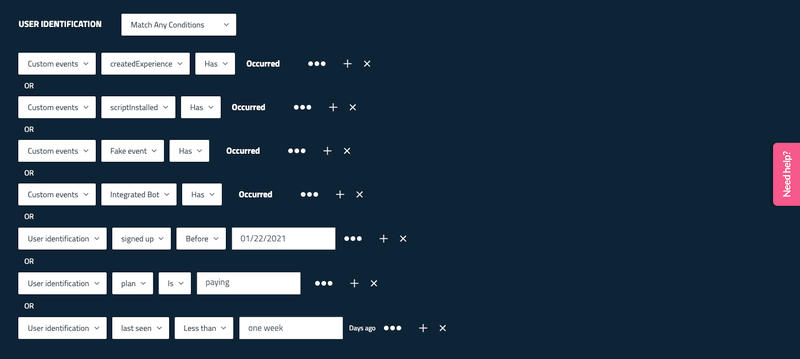
Source: Userpilot-Get advanced user segmentation features and takes action on that data! Consult with one of our product specialists today and see how you can build better experiences for your ideal users.
Now, you need to learn more about these users.
Step 2: Create an in-app survey for this segment
Now that you know which users fit into your segment you can give it a name like “Pareto’s segment” or “The A-team” whatever you think fits them best.
Next, you will want to create an in-app survey based on the three questions below:
- Who are they: What is their job title? Where do they work? Where do they live? How old are they? What is their culture?
- What is their primary goal: What is the job they are trying to do? What are they trying to achieve? How can your product make it easier?
- What is their main pain point to achieving this goal: Are there other solutions out there on the market that are outdated or are too time-consuming? Are they under a lot of pressure to submit something? What is the thing preventing them from completing the job?
Your survey should end up looking something like this:
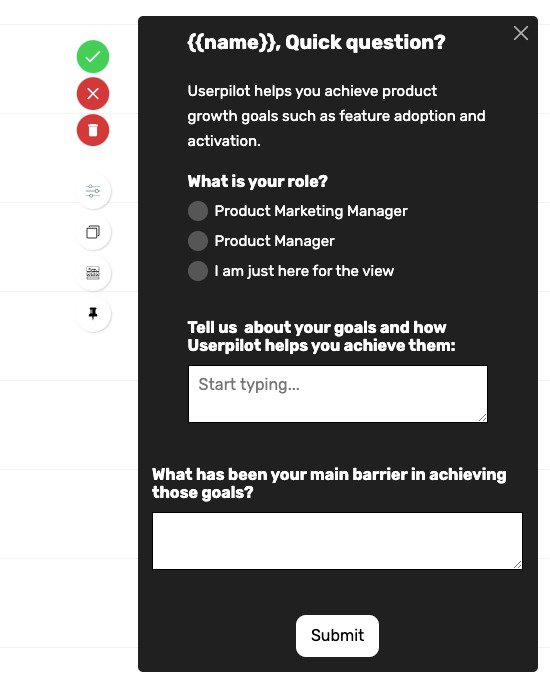
Source: Userpilot -Now that is a survey people would respond to! Increase your survey response rates and learn more about your users with easily deployable in-app surveys. No coding required!
Use the survey as an intro to an in-depth interview!
Better still, invite the user persona you’re targeting with your survey to a telephone interview. Simply add your Calendly link to the in-app survey.
What other questions can you ask when you have the chance to speak to your ideal user personas?
According to Nir Eyal, the author of ‘Hooked – How to Build Habit-Forming Products’ – the key to success is asking…why. A lot of times.
“One method is to try asking the question “Why?” as many times as it takes to get to an emotion. Usually, this will happen by the fifth why. This is a technique adapted from the Toyota Production System, described by Taiichi Ohno as the “5 Whys Method.” Ohno wrote that it was “the basis of Toyota’s scientific approach . . . by repeating ‘why?’ five times, the nature of the problem as well as its solution becomes clear.”
When it comes to figuring out why people use habit-forming products, internal triggers are the root cause, and “Why?” is a question that can help drill right to the core.”
This will help you build a consistent narrative around what makes your power user reach for your product.
According to Jack Dorsey, co-founder of Twitter and Square: “[If] you want to build a product that is relevant to folks, you need to put yourself in their shoes and you need to write a story from their side. So, we spend a lot of time writing what’s called user narratives.”
Step 3: Launch the survey and collect the data
Now that you have built your survey, you can go ahead and launch it so that it only appears for the segment you have just created.
You can decide what page the survey will appear on, at what frequency, and even if it will be shown after the user completes specific actions.
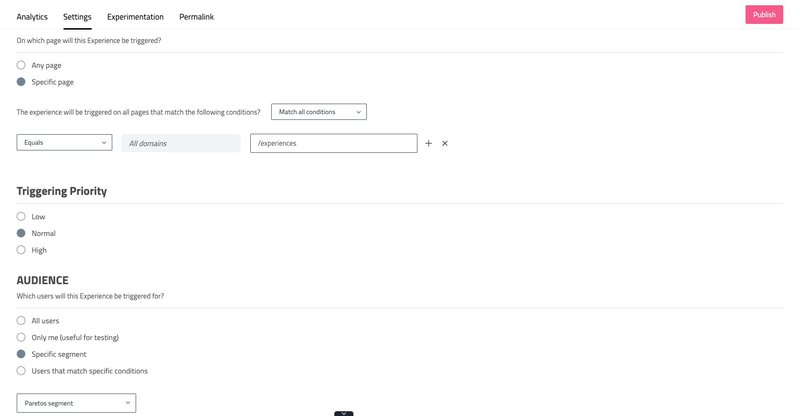
Once you run your survey for your desired time or just enough to get some responses, you can check your analytics tab results.
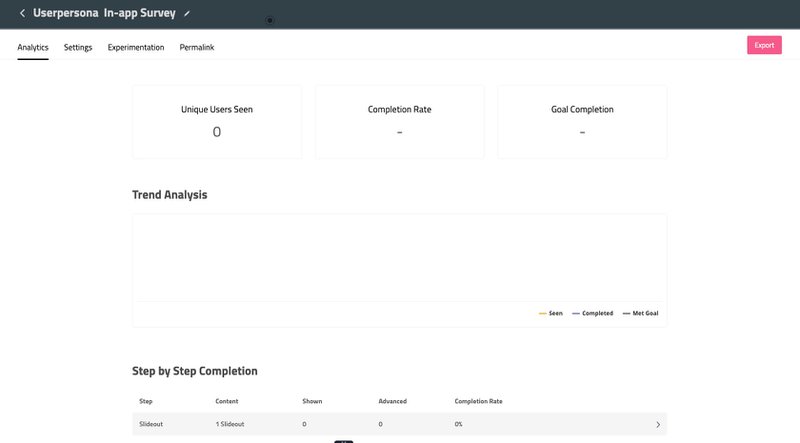
With this data in hand, you will be right on your way to filling out a user persona template-and it took less than an hour to set this all up!
Get a free consultation on how product experiences like these will increase your activation rates, decrease churn, and help you retain your ideal users.
Free User Persona Template for SaaS
Ok, you should now be all set to fill out your user persona template. Just keep in mind these key considerations:
- Your user’s goals and pain points will be the main data points in deciding what design or development solution to implement.
- Include information from all your departments. Your sales team, marketing team, customer success, and developers will all have their own unique insights.
- This isn’t a biography. Keep it simple.
- Make it look good. You are going to be staring at this and sharing it around a lot.
- Include psychological elements, think about what makes them human: behaviors, attitudes, opinions, and motivations.
- Use an image of the persona. This can be any stock photo; just avoid a celebrity photo or a co-worker, as this can add bias.
- Try to include their favorite brands. Obviously, this requires a bit more research but seeing where your users hang out can help you understand their likes and hobbies.
- Keep a standard design for all your user personas to make them easily comparable.
- Certain demographics will be more useful than others, like location and salary, depending on your app or website’s scope.
Free Template
Download your free user persona template here!
Look at the example below as a reference of what to include:
Photo
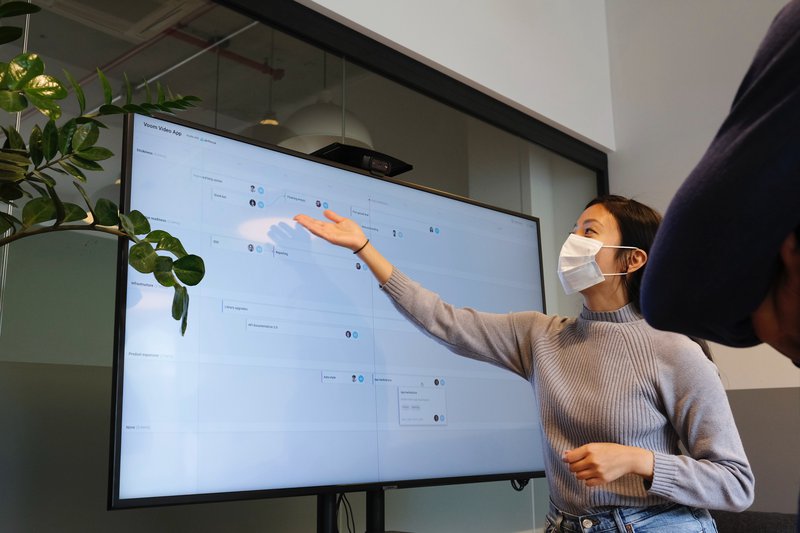
Name
Elizabeth Wu
Title/Company/Industry
- Product Marketing Manager/Content Daily/ SaaS content marketing.
- 50-150 employees.
- Found product market fit.
KPIs
- User Activation rates
- Product Feature Adoption – speaking of which:
- Feature Launches, Product Launches
- Time in App
- Free Trial Conversions
- ARR, MRR
Goals
- Decrease the amount of time it takes for users to become activated.
- Increase the amount of features that a user engages with.
- Make each feature/product launch successfully known throughout the user base and within the customer community.
Pain Points
- Product Marketing Manager’s role is often misunderstood or unknown to most of the organization.
- She can spend a ton of time working on something without actually producing measurable results.
- She is inundated with work that covers a wide variety of areas, and often doesn’t have time to take action within the product without requiring the help of engineers.
Wants and Needs
- Wants to be recognized more for her role in contributing to overall revenue growth.
- Wants to take action on her own time without having to wait for developers or take time off the road map.
- Needs a solution that directly impacts her KPIs.
Favorite Brands
- Apple
- Loom
- Atlassian
Wrapping things up
Creating user personas doesn’t always have to be time-consuming or spending hours sifting through empirical data. Of course, it depends on what you are trying to achieve, but the tips above are definitely a great place to start for a specific product/project.
The design you choose will complement the work you put in and help the information be top of mind. Hang your user personas on your wall, notice boards, and upload them in PDF format to your shared drives.
Make sure they are easily accessible for any time you develop a new feature to keep your product on track.
Don’t ever lose sight of the job that you are helping your user complete. It’s easy to get caught up in the minor details or making it seem like a living breathing person. By understanding the task, the user’s goals, and their challenges in completing them, you can still humanize those numbers in your analytics.

